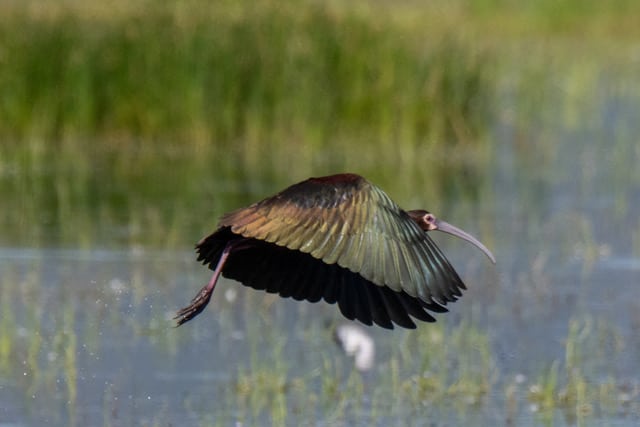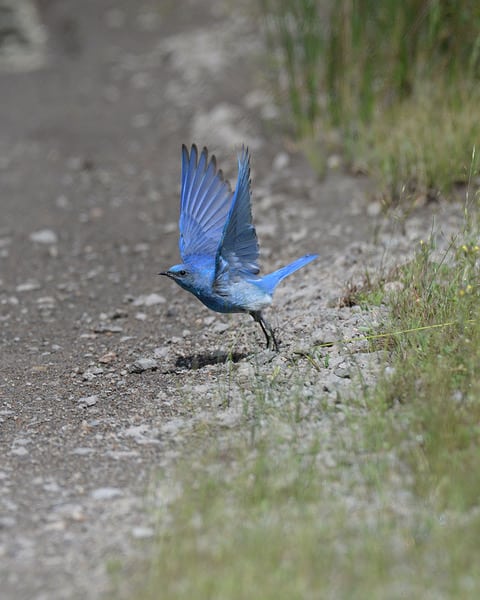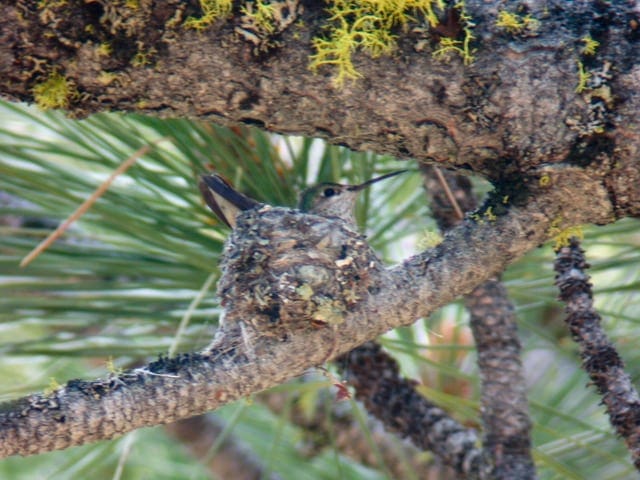High on birds: Birds of the Sierra
By Eric Schroeder
The first afternoon of the Golden Gate Bird Alliance class on Birds of the Sierra was going well. The twenty-one class members along with co-leaders Bob Lewis and Eddie Bartley and Eddie’s partner, Noreen Weeden, had assembled at Yuba Pass and began birding immediately. The first bird we saw was a Cassin’s Finch—a common enough bird for many birders, but a new one for me. Twenty minutes later Bob and Eddie identified one of those very pesky Empidonaxes, the Dusky Flycatcher, another first for me.
Great birds just kept coming: Mountain Chickadees, a Red-breasted Sapsucker, two White-headed Woodpeckers. Things got even more interesting in the final fifteen minutes with the sighting of two Evening Grosbeaks—again a new species for me. As we were turning to head back to the cars, I looked overhead and saw a raptor, an accipiter, I thought. I called it out to the group and Bob and Eddie were on it quickly. After a brief conference they concluded it was a Northern Goshawk, which Sibley Birds West describes as “rare.” For me, however, it wasn’t just rare, it was also new.

GGBA’s Sierra birding class had been on my radar for a couple of years. Each time I considered registering for it, however, the timing wasn’t quite right. Furthermore, I had heard that this class was very popular. This year I planned ahead, blocking off the time on my calendar months in advance. And on the day the class went on sale at 10 AM, I was ready—at my computer, with the GGBA webpage open. As the clock struck the hour, I hit “submit”; later that day I received the confirmation email that I was in. Now all I had to do was arrange a place to stay since I remembered that Bob had said housing could be hard to find in the Sierra Valley area. He had recommended the Canyon Ranch Resort near Sierraville, the most central location for the area we’d be exploring—northern Sierra county and southern Plumas country.
When I got Carla on the phone later that day, she told me she only had one cabin left. “I’ll take it,” I said. She told me it was her two-bedroom unit. “I’ll take it,” I said. She seemed skeptical but took my credit card information and said the cabin was mine. Luckily for me, Bob put out the word that I had room to spare. Sisters Nancy and Ann Buell got in touch, followed closely by Rich Banks. All three needed accommodation for the class. I had roommates. The sisters claimed the second bedroom and Rich took the sofa.
To prepare for the class, I went online to eBird and downloaded the species lists for the area we would be birding. I had never been birding in the Sierra before, so I expected that there would be a number of new species. Looking at the lists, I realized that there were potentially over twenty species I hadn’t seen before. But a second look told me that some of them would be tough. Sooty Grouse, anyone? I figured, though, that I should aim big, so I set myself a goal of ten new species. That first afternoon at Yuba Pass I realized that this goal might be achievable since I had four new species at this site alone.
The first two evenings of the trip were magical. On both, the group assembled in Sierraville then drove out into the Sierra Valley. The valley is huge, and its wetlands were teeming with Black-necked Stilts and American Avocets, with a few duck species thrown in for good measure. Yellow-headed Blackbirds perched conspicuously in the reeds that bordered the road. Above us the sky was filled with White-faced Ibises (one evening we counted about 300) and with White Pelicans (over 200). On the first evening, an American Bittern rose up from the marsh and flew alongside our car for about fifty yards before it veered off on other business.

On the second evening Eddie and Bob were on a two-fold mission. Their first objective was to get good looks at the Short-eared Owls that we had seen from a distance the night before. And, boy, did we see Short-eared Owls. We set out thirty minutes earlier than the previous evening and saw them perching, flying, hovering, and diving. Even the biggest owl junkie would have been high for a week off of this experience.
The second objective was to see Wilson’s Snipe (which we had missed the night before) and, hopefully, watch their winnowing flight display. As we stood waiting, Eddie and Bob talked about the sound made by the outer tail feathers as these birds perform their display flights—a noise that Sibley Birds West describes as sounding like “huhuhuhuhuhuhuhuhuhu, similar to Boreal Owl’s song.” Someone asked why they make this sound. Eddie explained that its function was to attract a mate, or, as Eddie put it, “The first time a female snipe ever heard this noise she said, “That’s radical, man!” Bob added her next line, “Better than sideburns!” It’s clear why these two guys have such a big fan club. And then as if on cue one showed up and did some stunt flying, its feathers imitating the song of a Boreal Owl.
On the morning of the second day we birded Sierra Valley in that same area. The wetland birds were even more plentiful by day. But the real stars were the raptors. Some of the usual suspects put in an appearance: Red-tailed Hawks, Turkey Vultures, and American Kestrels. But these were joined by a couple of Bald Eagles, a couple of Swainson’s Hawks, and two Falcons: a Prairie Falcon and a Peregrine.
By the second day, I had also begun to realize that I was in select company—there were only about five of us who were doing this class for the first time. My roommate Rich had done the class a couple of times previously, but not in a while. He was getting back into birding and thought this was the perfect local trip. Dawn Lemoine, who is currently enrolled in the GGBA yearlong Master Birder program, was doing the program for the fourth time; she loved the people on the trip: “I meet new ones each time I come.” Nearly everyone I talked to shared Ann Hoff’s love of the area’s beauty. Ann, who teaches Beginning Birding for GGBA, was on her eleventh class, explaining, “The Mountain Bluebird is my favorite bird.” Karen Anderson said she had done the class “many, many times”; she grew up in the area and considered it her “backyard.”

In the afternoon we made a special trip to seek out the Lewis’s Woodpecker (no relation to Bob). We could see the nest hole in a telephone pole. But the afternoon was warm and the bird had either flown or was holed up in the nest. Bob and Eddie decided that a short walk was in order and that afterwards we’d return and have another look for the woodpecker. Bob and I got separated from the rest of the group and wandered up a section of dry scrubby forest. Bob heard a Green-tailed Towhee calling (another target bird!) and so we wandered up the trail in search of it. At one point a Spotted Towhee popped out in front of us—wrong towhee! After a few minutes, I saw a bird on a tall dead tree in the distance that Bob suspected was our bird. As we got closer he dropped into the shrubbery around us. Being patient, we were finally rewarded with an appearance, a great close-up look.
Making our way back, we ran into the main group of birders who had not only seen the Green-tailed Towhee already but had also seen the Lewis’s Woodpecker. I was lucky—when we arrived back at the telephone pole, the bird was there. It had been described to me as looking like a crow from the back, but seeing it from the front there was no mistaking it as anything but a woodpecker.
Tragedy struck later that day. Rich, Nancy and I were driving back to our lodging, and Rich and I were wondering why we were seeing so many juvenile Red-tail Hawks (4-5) by the side of the road, apparently the victims of bird versus car encounters. Suddenly as if on cue a juvenile Red-tail loomed directly ahead. I braked but it crashed into the windshield, filling my field of view. As it bounced off and fell nearby, I slowed quickly and turned around. The bird was a heap of feathers in the tall grass by the roadside. I felt sick that I had struck and killed this beautiful bird.
As we approached it, however, it bobbed its head. It was alive! Now I felt bad in a different way, thinking I had crippled this bird and might have to finish it off. But then it made eye contact with us, and Rich and I started thinking about bird rescue. Next the hawk stood up and started walking! We were amazed. Its legs were fine! Rich wondered aloud whether we should prevent it from squeezing through the barbed wire fence if we were going to rescue it. Too late! It had accelerated. Next it half-jumped, half-flapped up on top of a fence post. A minute later it took off. This was beyond amazement. We weren’t any closer to the answer of why Red-tails had been crashing into cars, but we knew that at least one of them has survived the encounter and would perhaps be wiser in the future when crossing the road.
On the third day we set off in a new direction—to Carman Valley, a much smaller valley than Sierra. On our way into the valley we stopped to view the nest of a Calliope Hummingbird. We were in luck—mom was home. Superb look! Next was a short walk to seek the elusive Sooty Grouse. Bob and Eddie claimed they could hear this bird making its low booming subsonic call, but several others I talked to afterwards just shook their heads at this claim. (I must admit I’m a bit hearing-challenged—Bob played the Sooty Grouse call on his phone, and I had trouble hearing it while standing next to him!)

Finally into the valley itself. Bob spotted a Common Nighthawk high overhead, doing loops and circles. There were lots of species here but the real stars were the bluebirds, both Western and Mountain. It was obvious that the Mountain Bluebird was a big attraction for many in the group. It certainly was for me—another new species! And such a beautiful bird. My only regret in Carman Valley was that I missed the Townsend’s Solitaire which most people saw. It was one of my original target birds.
Later in the afternoon we birded Madora Lake—there weren’t a lot of birds but I had an excellent look at a Hermit Warbler (another first bird for me). It landed so close that I didn’t need binoculars to see it clearly. At Madora we also got our twelfth raptor of the trip—an Osprey.
Our final target bird on Day Three was the American Dipper, hopefully to be found under a bridge at a campground in Plumas-Eureka State Park. On the way, the group ahead of me spotted another Townsend’s Solitaire. John Missing, who knew I hadn’t seen the bird, called to me excitedly. But by the time I caught up, the bird had flown. John very graciously hung out with me for a few more minutes, hoping the bird would reappear, but that bird was gone. We had better luck with the dipper, however. As we stood on the bridge, the bird flew into the stream below us and started doing his characteristic bob. Very obliging!
On Day Four we woke up earlier than usual since we had to pack, eat breakfast, and drive about forty minutes to our meeting point. A steady rain greeted us, however. Eddie and Noreen were staying in the next cabin, so I checked in after breakfast about the day’s plans. Bob had just dropped in, too. They discussed options, finally deciding to cancel the morning walk since much of it would be on an exposed slope, with the rain predicted to continue, along with the possibility of thunderstorms. They did this with great reluctance—they have been leading this class for almost 25 years and had never previously canceled because of weather.
The day after I returned from the mountains Bob sent out eBird lists for the trip. Having done the Master Birder class with Bob and Eddie, I’m now conditioned to do my own record keeping. I had been pleased with my weekend count of 84 species. When I looked at Bob’s lists, I expected to see 20–30 species I had missed. I was very gratified to find that there were only eleven. But what pleased me most about the birds I had seen was that of those 84, fifteen were new species. Will I go back? Definitely. That Townsend’s Solitaire is still up in those mountains! Probably hanging out with the Sooty Grouse.
Eric Schroeder worked at UC Davis where he had a thirty-year career as a lecturer and administrator. He taught for several departments—including the University Writing Program, the English Department, and the American Studies Program—and spent his last decade at UCD as the Director of Study Abroad for which he still leads summer programs in Australia, South Africa, and Scotland. His local volunteer work includes serving as president of the Tilden Wildcat Horseman’s Association for seven years and being a member of the East Bay Regional Park District’s Volunteer Mounted Patrol. He recently completed the Master Birder Program sponsored by GGBA and the Academy of Science.
